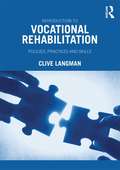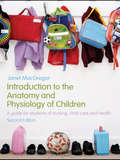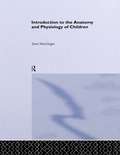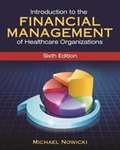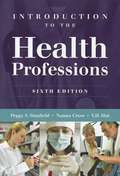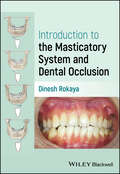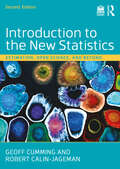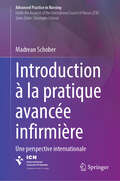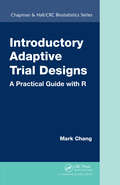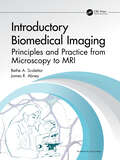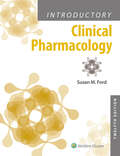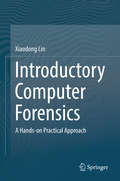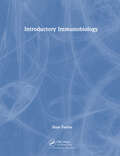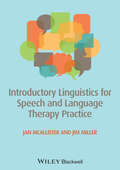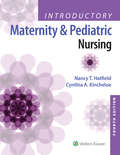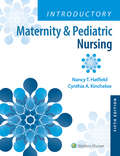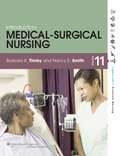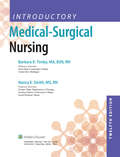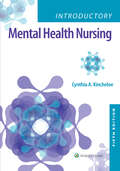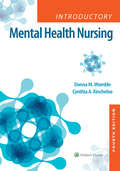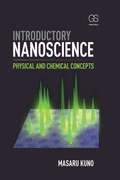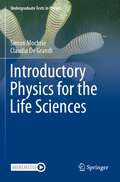- Table View
- List View
Introduction to Vocational Rehabilitation: Policies, Practices and Skills
by Clive LangmanThis text provides an overview of vocational rehabilitation (VR) practice, making it the perfect companion for students and practitioners with an interest in supporting people back to work and improving their sense of health and well-being. The book is divided into three parts: the first covers the policy context of VR in the UK, defining VR, outlining the development of national standards in the sector, and looking at issues such as the economy and worklessness, and the legal background. The second part examines models of VR practice and relevant standards. It explores the nature of developing services in the public and private sectors, illustrated by case studies from a range of disciplinary backgrounds. The final part presents a detailed introduction to the knowledge and skills required in providing a VR service, including consideration of the multidisciplinary processes and stages involved. Introduction to Vocational Rehabilitation includes numerous case studies and a dedicated chapter of issues and questions to aid reflection. Comprehensive and evidence-based, this is the first multidisciplinary textbook for students and practitioners from a range of backgrounds, including occupational therapy and health, physiotherapy, human resources, nursing, social work and health psychology.
Introduction to the Anatomy and Physiology of Children: A Guide for Students of Nursing, Child Care and Health
by Janet MacGregorFully updated, this new edition provides an introduction to normal, healthy physical development for all professionals who specialise in working with children. The author, an experienced nurse teacher, guides the reader through the key changes in body systems and functions from embryo to birth through childhood and adolescence. Chapter 1 sets the scene for physical needs in child development, such as the need to be warm and safe. Chapters 2 to 9 cover the body systems: skeletal; nervous; cardiovascular; respiratory; renal; digestive; reproductive; and immune. The embryology and physiological function at birth is explored in each chapter before the text moves on through the many changes over the next decade to puberty and the arrival at adult functioning. A new final chapter provides a holistic account of children’s development, body and mind. Each chapter is illustrated with line drawings and tables, and ends with scenarios which illustrate how knowledge supports good practice in a real-life situation, and a quiz to consolidate learning. Concise and clearly written, this introductory text will be essential reading for all those working with children and families in the health and social care sector, enabling them to ensure children enjoy a safe and healthy childhood in line with Every Child Matters and new national service framework directives.
Introduction to the Anatomy and Physiology of Children: A Guide for Students of Nursing, Child Care and Health
by Janet MacGregorPublished in 2002, 'Introduction to the Anatomy and Physiology of Children' is a valuable addtion to Allied Health.
Introduction to the Financial Management of Healthcare Organizations (Gateway to Healthcare Management)
by Michael NowickiNew information on capitation, entitlement reform, cost-benefit and cost-effectiveness analyses, and financial statements Recent legal action related to the distinctions between for-profit and not-for-profit hospitals Information regarding federal government actions against providers on fraud and abuse allegations
Introduction to the Health Professions (Sixth Edition)
by Nanna Cross Y. H. Hui Peggy S. StanfieldCompletely updated, Introduction to the Health Professions, Sixth Edition provides the most current, comprehensive coverage of all the major health professions. This popular text outlines more than 75 careers and touches on every major facet of the field including training requirements, job responsibilities, and salaries. This fundamental resource provides a thorough review of the U. S. healthcare delivery system, managed care, health care financing, reimbursement, insurance coverage, Medicare, Medicaid, and the impact of new technology on healthcare services. Written specifically for students who plan to become healthcare professionals, this text will give you all the information you need for a successful career! New Topics and Updates in the Sixth Edition Historical review of the health insurance industry in the United States Expanded discussion of public health care--Medicaid, Medicare, and Children's Health Insurance Program (CHIP)New section on healthcare reform due to the Patient Protection and Affordable Care Act of 2010Up-to-date coverage of individual states' implementation of healthcare reform Future-looking perspective on the evolving roles and responsibilities in health careers and the impact of future demographic and socioeconomic changes on healthcare needs Useful information on educational grants and loan repayment programs Current data for each profession from the latest Occupational Outlook (U. S. Department of Labor, 2010 - 2011)New chapter with current information on athletic trainers Instructor Resources: Transition Guide, Instructor's Manual, PowerPoint Presentations, and a Test Bank. Student Resources: Companion Website Instructors: Bundle this product with additional Jones & Bartlett introductory health professions texts and save your students up to 30% off list price. Contact your Account Specialist for more information.
Introduction to the Masticatory System and Dental Occlusion
by Dinesh RokayaA comprehensive introduction to the masticatory system and its relation to dental occlusion Introduction to the Masticatory System and Dental Occlusion meets the need for a rigorous guide to the masticatory system and how it relates to dental occlusion to aid interventions. The text offers a sound understanding of functioning dental anatomy and the biomechanics that are essential to understanding dental occlusion. It covers all structures required for chewing: jaws and jaw muscles, teeth, joints, and tongue as well as other significant areas including the vascular and nervous systems that supply these structures with blood and stimulation. Beginning with the understanding of these concepts, the author provides further guidance on oral function, esthetics, and alerting patients to potential issues. Introduction to the Masticatory System and Dental Occlusion readers will also find: A thorough introduction to the basic structure and function of the masticatory systemDetailed coverage of subjects including TMJ, mastication muscles, occlusal therapy, and more Images to illustrate key concepts and systems Advice on choosing the correct medical intervention in each case Introduction to the Masticatory System and Dental Occlusion is ideal for undergraduate and postgraduate dental students for subjects such as masticatory systems, dental anatomy, restorative dentistry, and prosthodontics, as well as for practicing dentists and medical professionals in related fields.
Introduction to the New Statistics: Estimation, Open Science, and Beyond
by Geoff Cumming Robert Calin-JagemanThis fully revised and updated second edition is an essential introduction to inferential statistics. It is the first introductory statistics text to use an estimation approach from the start and also to explain the new and exciting Open Science practices, which encourage replication and enhance the trustworthiness of research. The estimation approach, with meta-analysis (“the new statistics”), is exactly what’s needed for Open Science.Key features of this new edition include: Even greater prominence for Open Science throughout the book. Students easily understand basic Open Science practices and are guided to use them in their own work. There is discussion of the latest developments now being widely adopted across science and medicine. Integration of new open-source esci (Estimation Statistics with Confidence Intervals) software, running in jamovi. This is ideal for the book and extends seamlessly to what’s required for more advanced courses, and also by researchers. See www.thenewstatistics.com/itns/esci/jesci/. Colorful interactive simulations, including the famous dances, to help make key statistical ideas intuitive. These are now freely available through any browser. See www.esci.thenewstatistics.com/. Coverage of both estimation and null hypothesis significance testing (NHST) approaches, with full guidance on how to translate between the two. Effective learning strategies and pedagogical features to promote critical thinking, comprehension and retention Designed for introduction to statistics, data analysis, or quantitative methods courses in psychology, education, and other social and health sciences, researchers interested in understanding Open Science and the new statistics will also appreciate this book. No familiarity with introductory statistics is assumed.A comprehensive website offers data sets, key term flashcards, learning guides, and videos describing key concepts and demonstrating the use of esci. For instructors, there are guides for teaching the new statistics and Open Science, assessment exercises, question banks, downloadable slides, and more. Altogether, the website provides engaging learning resources for traditional or flipped classrooms. See www.routledge.com/cw/cumming.
Introduction to the Science of Medical Imaging
by R. Nick BryanRevolutionary advances in imaging technology that provide high resolution, 3-D, non-invasive imaging of biological subjects have made biomedical imaging an essential tool in clinical medicine and biomedical research. Key technological advances include MRI, positron emission tomography (PET) and multidetector X-ray CT scanners. Common to all contemporary imaging modalities is the creation of digital data and pictures. The evolution from analog to digital image data is driving the rapidly expanding field of digital image analysis. Scientists from numerous disciplines now require in-depth knowledge of these complex imaging modalities. Introduction to the Science of Medical Imaging presents scientific imaging principles, introduces the major biomedical imaging modalities, reviews the basics of human and computer image analysis and provides examples of major clinical and research applications. Written by one of the world's most innovative and highly respected neuroradiologists, Introduction to the Science of Medical Imaging is a landmark text on image acquisition and interpretation.
Introduction to the US Food System
by Roni NeffA public health approach to the US food systemIntroduction to the US Food System: Public Health, Environment, and Equity is a comprehensive and engaging textbook that offers students an overview of today's US food system, with particular focus on the food system's interrelationships with public health, the environment, equity, and society. Using a classroom-friendly approach, the text covers the core content of the food system and provides evidence-based perspectives reflecting the tremendous breadth of issues and ideas important to understanding today's US food system. The book is rich with illustrative examples, case studies, activities, and discussion questions.The textbook is a project of the Johns Hopkins Center for a Livable Future (CLF), and builds upon the Center's educational mission to examine the complex interrelationships between diet, food production, environment, and human health to advance an ecological perspective in reducing threats to the health of the public, and to promote policies that protect health, the global environment, and the ability to sustain life for future generations.Issues covered in Introduction to the US Food System include food insecurity, social justice, community and worker health concerns, food marketing, nutrition, resource depletion, and ecological degradation.Presents concepts on the foundations of the US food system, crop production, food system economics, processing and packaging, consumption and overconsumption, and the environmental impacts of foodExamines the political factors that influence food and how it is producedIdeal for students and professionals in many fields, including public health, nutritional science, nursing, medicine, environment, policy, business, and social science, among othersIntroduction to the US Food System presents a broad view of today's US food system in all its complexity and provides opportunities for students to examine the food system's stickiest problems and think critically about solutions.
Introduction à la pratique avancée infirmière: Une perspective internationale (Advanced Practice in Nursing)
by Madrean SchoberPublié sous les auspices du Conseil international des infirmières (CII), cet ouvrage offre une vue d’ensemble de la pratique avancée infirmière qui connaît actuellement un grand essor. Il aborde les questions centrales relatives aux fonctions regroupées sous cette appellation et au développement de ce type d’exercice. Ces questions sont fondamentales pour définir et distinguer la nature de la pratique avancée. Les sujets abordés comprennent la définition de ce type d’exercice, ses caractéristiques, le champ d’exercice, la formation préparant à un exercice en pratique avancée, la réglementation et la contribution apportée par la recherche. Les obstacles et les facilitateurs de l’exercice en pratique avancée sont présentés, y compris les questions éthiques qui se posent dans le contexte de son développement. Ce livre examine les développements internationaux dans ce domaine, comme le reflètent les études de cas et les exemples spécifiques à chaque pays. Il constitue une ressource précieuse pour les infirmières en pratique avancée, les enseignants, les responsables d’encadrement des établissements de santé. Ce livre a été traduit de l’anglais à l’aide d’une intelligence artificielle. Une révision du contenu a ensuite été effectuée par un expert du domaine.
Introductory Adaptive Trial Designs: A Practical Guide with R
by Mark ChangAll the Essentials to Start Using Adaptive Designs in No TimeCompared to traditional clinical trial designs, adaptive designs often lead to increased success rates in drug development at reduced costs and time. Introductory Adaptive Trial Designs: A Practical Guide with R motivates newcomers to quickly and easily grasp the essence of adaptive desig
Introductory Biological Statistics (3rd Edition)
by Raymond E. Hampton John E. HavelHampton and Havel's clear, approachable text has guided a generation of biology students through their first foray into statistics. The third edition continues to provide a thorough grounding in all essential methods of descriptive and inferential statistics, ideal for any student seeking a career in experimental sciences. Each chapter has been carefully updated and restructured to enhance understanding, better bridge the gaps between topics, and create a pragmatic approach to learning the many uses of statistics in biology. The authors complement their descriptions with an abundance of examples and exercises that illustrate how to choose and apply statistical procedures and interpret their results in real-world scenarios, allowing students to develop and test their understanding while building their confidence with the material. The third edition explores changing standards of technology and includes new boxed examples written by experts on computer-intensive resampling methods, multivariate analysis, and meta-analysis. Use of Minitab's outstanding statistical software (now included on the CD accompanying the book) is incorporated through the text.
Introductory Biomedical Imaging: Principles and Practice from Microscopy to MRI (Imaging in Medical Diagnosis and Therapy)
by Bethe A. Scalettar James R. AbneyImaging is everywhere. We use our eyes to see and cameras to take pictures. Scientists use microscopes and telescopes to peer into cells and out to space. Doctors use ultrasound, X-rays, radioisotopes, and MRI to look inside our bodies. If you are curious about imaging, open this textbook to learn the fundamentals. Imaging is a powerful tool in fundamental and applied scientific research and also plays a crucial role in medical diagnostics, treatment, and research. This undergraduate textbook introduces cutting-edge imaging techniques and the physics underlying them. Elementary concepts from electromagnetism, optics, and modern physics are used to explain prominent forms of light microscopy, as well as endoscopy, ultrasound, projection radiography and computed tomography, radionuclide imaging, and magnetic resonance imaging. This textbook also covers digital image processing and analysis. Theoretical principles are reinforced with illustrative homework problems, applications, activities, and experiments, and by emphasizing recurring themes, including the effects of resolution, contrast, and noise on image quality. Readers will learn imaging fundamentals, diagnostic capabilities, and strengths and weaknesses of techniques. This textbook had its genesis, and has been vetted, in a "Biomedical Imaging" course at Lewis & Clark College in Portland, OR, and is designed to facilitate the teaching of similar courses at other institutions. It is unique in its coverage of both optical microscopy and medical imaging at an intermediate level, and exceptional in its coverage of material at several levels of sophistication.
Introductory Clinical Pharmacology
by Susan FordDeveloped by nurses for nurses, Introductory Clinical Pharmacology, 12th Edition, combines impeccably accurate drug information, an easy-to-read writing style, a practical nursing process approach, and powerful online resources to help students easily grasp challenging concepts and learn to confidently apply them in clinical practice. This proven, practice-oriented resource not only helps students understand drugs and their effects, but also teaches students to effectively relay information to clients, building the critical thinking and problem-solving skills for success on the NCLEX-PN® and in nursing practice.
Introductory Computer Forensics: A Hands-on Practical Approach
by Xiaodong LinThis textbook provides an introduction to digital forensics, a rapidly evolving field for solving crimes. Beginning with the basic concepts of computer forensics, each of the book’s 21 chapters focuses on a particular forensic topic composed of two parts: background knowledge and hands-on experience through practice exercises. Each theoretical or background section concludes with a series of review questions, which are prepared to test students’ understanding of the materials, while the practice exercises are intended to afford students the opportunity to apply the concepts introduced in the section on background knowledge. This experience-oriented textbook is meant to assist students in gaining a better understanding of digital forensics through hands-on practice in collecting and preserving digital evidence by completing various exercises. With 20 student-directed, inquiry-based practice exercises, students will better understand digital forensic concepts and learn digital forensic investigation techniques. This textbook is intended for upper undergraduate and graduate-level students who are taking digital-forensic related courses or working in digital forensics research. It can also be used by digital forensics practitioners, IT security analysts, and security engineers working in the IT security industry, particular IT professionals responsible for digital investigation and incident handling or researchers working in these related fields as a reference book.
Introductory Immunobiology
by Huw DaviesA brief treatment of immunobiology for second year undergraduates with little previous knowledge of the topic. The author illustrates molecular, biochemical and cellular phenomena with reference to all areas of zoology, including invertebrates, to draw out common themes and principles.
Introductory Linguistics for Speech and Language Therapy Practice
by James E. Miller Jan McallisterThis practical introduction to linguistics is a must-have resource for all speech and language therapy students, providing you with the fundamental theory needed as a foundation for practice.Written by authors with extensive experience in both research and teaching, Introductory Linguistics for Speech and Language Practice equips you with a practical understanding of relevant linguistic concepts in the key language areas of morphology, syntax, semantics, discourse and pragmatics. Each chapter opens by explaining why the information is of relevance to the speech language therapist, and this integrated approach is emphasised via reference to relevant clinical resources. Exercises throughout each chapter also allow you to test your understanding of key principles and apply this knowledge to other areas of your study.This concise, readable guide is a core text for all undergraduate and postgraduate students of speech and language therapy, and is also ideal for qualified therapists wanting to enrich their understanding of the linguistic assessments they use in practice.
Introductory Maternity and Pediatric Nursing
by Nancy T. Hatfield Cynthia KincheloePublisher’s Note: Products purchased from 3rd Party sellers are not guaranteed by the Publisher for quality, authenticity, or access to any online entitlements included with the product. Master maternity and pediatric nursing skills and prepare for the NCLEX-PN exam with this current, easy-to-understand, highly visual text. This edition provides everything you need to make the transition from the classroom to safe, effective practice, including content that reflects today’s best practices, a unique built-in workbook, integrated case studies, and a robust array of interactive online resources.
Introductory Maternity and Pediatric Nursing
by Cynthia Kincheloe Nancy HatfieldPrepare today’s LPN/LVN students for success on the NCLEX-PN® and in clinical practice with this proven introduction to the essentials of maternity and pediatric nursing. Designed specifically for the LPN curriculum, Introductory Maternity and Pediatric Nursing, 5th Edition, focuses on need-to-know coverage of pregnancy, birth, and pediatrics, combining a clear, straightforward approach with built-in workbook features that reinforce understanding without the need for an additional study guide. Accompanied by engaging online resources, this up-to-date learning package provides the ideal foundation for your students’ success in LPN/LVN practice.
Introductory Medical-Surgical Nursing (Eleventh Edition)
by Barbara K. Timby Nancy E. SmithThis 11th Edition of Timby and Smith's best-selling text equips LPN/LVN students with the practical knowledge and skills necessary to provide safe and effective nursing care to today's medical-surgical clients. <p><p> Acclaimed for its highly visual and easy-to-understand presentation, this edition prepares you to manage client nursing care in today's changing healthcare environments and eases the transition from classroom to clinical practice.
Introductory Medical-Surgical Nursing (Point (lippincott Williams And Wilkins) Ser.)
by Barbara Kuhn Timby Nancy E. SmithPublisher’s Note: Products purchased from 3rd Party sellers are not guaranteed by the Publisher for quality, authenticity, or access to any online entitlements included with the product. This updated 12th Edition of Introductory Medical-SurgicalNursing and its interactive online resources equips LPN/LVN students with the practical knowledge and skills necessary to provide safe and effective nursing care to adult medical-surgical clients in today’s changing healthcare environment. This edition reflects current medical and nursing practice through accessible content enhanced by photos and illustrations, as well as online videos, practice NCLEX-PN® questions, and more, to prepare students for real-world nursing and NCLEX-PN success.
Introductory Mental Health Nursing
by Cynthia A. KincheloeUpdated, easy to read, and designed specifically for today’s LPN/LVN students, Introductory Mental Health Nursing, 5th Edition, makes the realities of mental health nursing approachable and prepares students to confidently manage clients’ mental healthcare needs across a wide range of care settings. This extensively revised 5th Edition delivers clear, comprehensive, clinically relevant information reflecting the care needs of a diverse client population. Powerful built-in study aids strengthen students’ critical thinking and clinical application capabilities to prepare them for any challenge they may encounter.
Introductory Mental Health Nursing
by Cynthia Kincheloe Donna WomblePublisher's Note: Products purchased from 3rd Party sellers are not guaranteed by the Publisher for quality, authenticity, or access to any online entitlements included with the product. Introductory Mental Health Nursing, 4th Edition Donna Womble, MEd, BS, RN; and Cynthia A. Kincheloe, MSN, BSN, ADN, RN Confidently manage the mental health issues you’ll encounter across a wide range of health care settings. Written specifically for LPN/LVN students, Introductory Mental Health Nursing, 4th Edition, equips you for the challenges of modern mental health nursing with clear, direct, clinically relevant information reflecting the most up-to-date perspectives in the field. This acclaimed text establishes essential groundwork then builds on fundamental concepts to instill a confident understanding of the delivery of mental health care, the nursing process and its relation to mental health, and the management of specific psychiatric disorders to prepare you for success from the classroom to your career. Enhanced! Case applications guide you in applying the nursing process to resolve clinical problems. Updated! Chapter-ending Student Worksheets reinforce key concepts through fill-in-the-blank, matching, and multiple-choice NCLEX®-style questions. At a Glance sections highlight or summarize essential information for stronger recall and retention. Just the Factsentries distill critical details for faster, more efficient review. Mind Jogger critical thinking questions promote deeper understanding. At-A-Glance Senior Focus helps you confidently prepare for the care of older adults or elderly clients. Updated terminology helps you ensure the most effective clinical communication.
Introductory Nanoscience: Physical and Chemical Concepts
by Masaru KunoDesigned for students at the senior undergraduate and first-year graduate level, Introductory Nanoscience takes a quantitative approach to describing the physical and chemical principles behind what makes nanostructures so fascinating. This textbook provides a foundation for understanding how properties of materials change when scaled to nano-size, explaining how we may predict behavior and functionality.
Introductory Physics for the Life Sciences (Undergraduate Texts in Physics)
by Simon Mochrie Claudia De GrandiThis classroom-tested textbook is an innovative, comprehensive, and forward-looking introductory undergraduate physics course. While it clearly explains physical principles and equips the student with a full range of quantitative tools and methods, the material is firmly grounded in biological relevance and is brought to life with plenty of biological examples throughout.It is designed to be a self-contained text for a two-semester sequence of introductory physics for biology and premedical students, covering kinematics and Newton’s laws, energy, probability, diffusion, rates of change, statistical mechanics, fluids, vibrations, waves, electromagnetism, and optics. Each chapter begins with learning goals, and concludes with a summary of core competencies, allowing for seamless incorporation into the classroom. In addition, each chapter is replete with a wide selection of creative and often surprising examples, activities, computational tasks, and exercises, many of which are inspired by current research topics, making cutting-edge biological physics accessible to the student.
